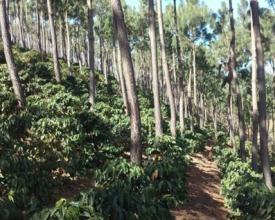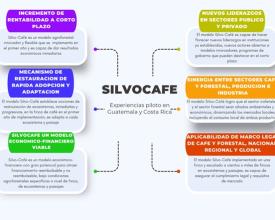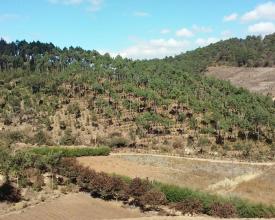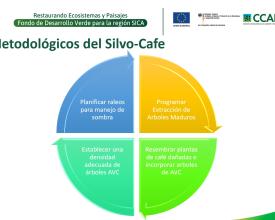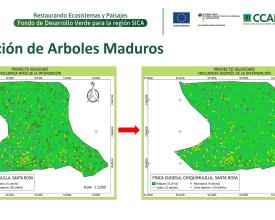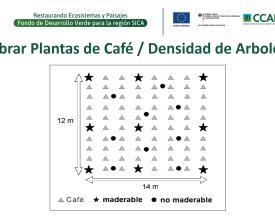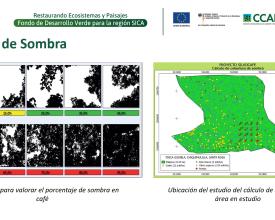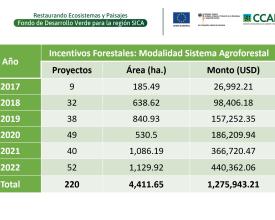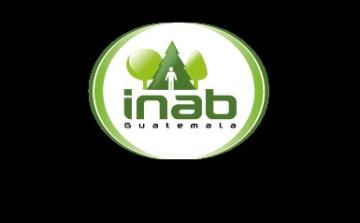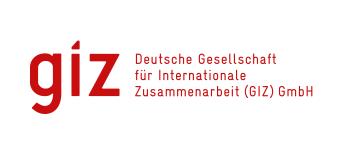
Silvocafé - Incorporating forestry management in coffee farms as a restoration strategy
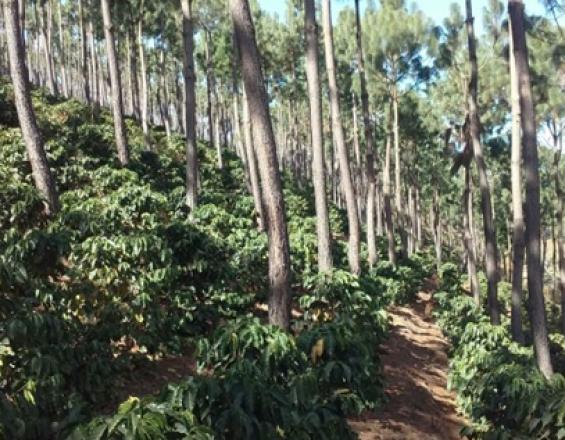
In Central America, coffee production has been negatively impacted by the instability of prices, impacting small coffee growers and especially those with coffee plantations in medium and low zones with standard quality.
Silvocafé is an agroforestry business model for shade coffee plantations that adds the management and silvicultural use of native and high commercial value (HCV) trees. The solution is based on the experiences implemented in Guatemala and Costa Rica.
The Silvocafé model, when implemented, allows the coffee grower to restore the ecosystem by improving ecosystem services (erosion prevention, water catchment, reduction of landscape fragmentation, increased carbon sequestration and biodiversity conservation) on his land, while at the same time producing timber by-products with HCV trees, with short, medium and long term returns, according to his planning.
Context
Challenges addressed
- Volatility in coffee prices, due to the reduction of international exports, the devaluation of the local currency of producing countries, the upstream value chain at the farm level and future coffee markets that are subject to financing.
- Pests and diseases that affect crop yields and thus the income from commercial activity; for example, coffee rust reduced production from 19.14 quintals of gold/ha to 14.7 quintals of gold/ha in 2019, and the lack of renewal of coffee plantations.
Location
Process
Summary of the process
The incorporation of forest management to coffee cultivation (B1) by itself is functional at the farm level, bringing benefits to the individual who applies it, since it establishes the criteria and technical parameters to combine the production of coffee and wood, without one affecting the other, keeping coffee as the main crop and wood as a by-product in the productive unit.
While incorporating coffee development measures in forestry policies (B2); aims to amplify the benefits of B1 at the national level, through modification and/or adaptation of national programs.
Finally, B1 functions as a laboratory, where tests can be carried out on the applicability of the measures proposed for B2 and encourage discussions among B2 stakeholders.
Building Blocks
Incorporation of Forest Management into Coffee Cultivation
Silvocafe is a restoration technique that seeks to make wood production viable in coffee plantations, through the incorporation and management of a density of trees -AVC- as "shade trees". The steps to execute it are:
- Extraction of mature trees: with a census and georeferencing of trees with DBH>10 cm, an extraction is carried out using the following criteria: frequency per hectare, phytosanitary condition, tree shape, density by species of interest and distribution.
- Replant damaged coffee plants and incorporate HCV trees: each extracted tree affects approximately 20 coffee plants, that is, 500 to 700 plants/ha, which means a replanting of plants/ha of 10%-15% after each intervention.
- Establish an adequate shade density of trees of high commercial value: this requires a stock of between 40 to 60 HCV trees/ha; with a recommended spacing of 12x14 m.
- Plan thinning for shade improvement: Higher shade density (50-70% cover, 50-30% light) is justified when the crop site has high ambient and soil temperatures, low ambient and soil relative humidity, greater exposure to sunlight, poor soil fertility and low altitude above sea level.
Enabling factors
It is preferable to apply it in prime-extra-prime coffee plantations (0-1000 masl); since in hard-semiduro (1000-1400 masl) and strictly hard coffee (+14000 masl), due to their level of production qq gold/ha and their differentiated prices reached in the market, the adoption of this technique may not be attractive.
Lesson learned
It is important to select the species of trees of high commercial value to be selected as shade trees for coffee, their own genotypic and phenotypic conditions, the market interest in the species and, most importantly, their interaction with the crop, since economic yields will depend on this decision.
Incorporate Coffee Development Measures into Forestry Policies
The purpose of this building block is to develop agroforestry systems management policies in line with coffee growing and link them to the country's forestry development policies, responding to the challenges of the market and applicable international legislation.
In essence, it is necessary to promote incentive policies (economic and/or commercial) that stimulate agroforestry in coffee plantations at the same time, the value chains in the forestry sector as small timber.
This requires two main elements:
- The ability to adjust forestry programs to accommodate agroforestry elements, without undermining coffee production but maintaining the spirit of the forestry policy.
- Encourage intersectoral dialogue around the issue of agroforestry in coffee plantations, in order to identify points of technical and political coincidence.
To illustrate this building block, the case of the Forestry Incentives Program of Guatemala -PROBOSQUE- is used; which made adjustments to the modality of forestry incentives in the agroforestry modality, changing parameters to include the cultivation of coffee, having a greater impact.
Enabling factors
- To have a clear forest policy framework, which first, determines the scope of its objective as a public policy, the subject that expects to benefit and the expected results of its implementation; second, the issues where it can and should generate synergies to achieve the objectives of the forest policy.
- To have consolidated public policy instruments that allow interaction with other productive sectors. Guatemala's Forestry Incentives Program -PROBOSQUE- originated in 1996 and continues to operate to date.
Lesson learned
- The development of pilot initiatives is required to evaluate and/or test the technical hypotheses of the different stakeholders in adjusting public policy instruments; in this case the public forestry sector and the organized private coffee sector.
- Extensive internal and external discussion and consultation processes are required among the different stakeholders to achieve the benefits of the different sectors, without affecting the institutional and legal mandates that the stakeholders must comply with.
- Technical materials need to be developed in order to communicate and disseminate information to potential stakeholders on the new modalities offered by public policy instruments.
Impacts
The impacts of the implementation of the Silvocafe model are:
- The introduction of 40 to 60 HCV trees/ha in coffee crops with tree densities between 209 - 125 trees/ha, resulting in a final harvest density of 12% of HCV trees equivalent to the extraction of 20 to 30 trees/ha. without affecting the yield of shade coffee.
- Increased income from the extraction of HCV trees, which, depending on their market value, varies between USD $ 3,668.70 USD and $ 20,068.58 per hectare.
- Improved ecosystem services; with an increase of 2.52 tC/ha/year, increased water infiltration of 2.4 mm/ha/year, 5.4% reduction in erosion per year and reduced habitat fragmentation due to increased forest cover.
Beneficiaries
- Producers with coffee crops of standard quality between an altitudinal range of 0-1000 meters above sea level.
- In degraded coffee plantations and/or with low yields (60-90 qq/ha).
- On degraded land that can be restored through an agroforestry system.
Sustainable Development Goals
Story
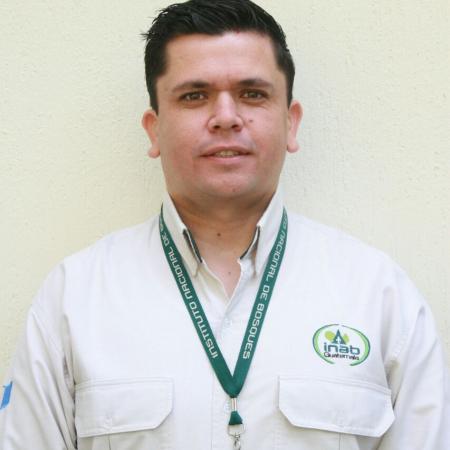
"There were complaints from the users of the forestry incentives because they considered that the densities of forest species recommended by INAB for agroforestry systems were too high, which affected the development of coffee crops. The research to determine the optimum density of forest species in coffee plantations determined that this should be 120 forest trees per hectare, of which 60 should be commercially valuable timber species. The results of the research were incorporated into the PROBOSQUE regulations approved in 2020, which will contribute to improving forest cover through these systems". Hugo Flores, Director of Forest Management and Restoration, INAB.

